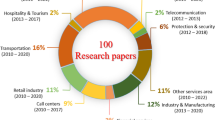Abstract
In a context of labor shortage and strong global competition for talent, salary management is becoming a critical issue for companies wishing to attract, engage and retain qualified employees. This paper presents a multi-objective optimization model to balance the internal equity, external equity and costs trade-offs associated with the design of salary structures. Solutions are generated to estimate and explore the Pareto frontier using real compensation data from a unionized establishment in the public sector. Our work shows the interest of using combinatorial optimization techniques in the design of salary structures.
Access this chapter
Tax calculation will be finalised at checkout
Purchases are for personal use only
Similar content being viewed by others
References
Armstrong, M., Chapman, A.: The Reward Management Toolkit: A Step-By-Step Guide to Designing and Delivering Pay and Benefits. Kogan Page, London (2011)
Barry, G., Newman, J.: Compensation, 13th edn. McGraw-Hill, New York (2019)
Branch, L.S.: Consolidated federal laws of Canada, Pay Equity Act (2021). https://laws-lois.justice.gc.ca/eng/acts/p-4.2/FullText.html. Accessed 31 Aug 2021
Bruno, J.E.: Compensation of school district personnel. Manage. Sci. 17(10), B569–B587 (1971). http://www.jstor.org/stable/2628995. INFORMS
Chalumeau, F., Coulon, I., Cappart, Q., Rousseau, L.-M.: SeaPearl: a constraint programming solver guided by reinforcement learning. In: Stuckey, P.J. (ed.) CPAIOR 2021. LNCS, vol. 12735, pp. 392–409. Springer, Cham (2021). https://doi.org/10.1007/978-3-030-78230-6_25
Downes, P.E., Choi, D.: Employee reactions to pay dispersion: a typology of existing research. Hum. Resour. Manag. Rev. 24(1), 53–66 (2014). https://doi.org/10.1016/j.hrmr.2013.08.009
Kassa, B.A.: A decision support model for salary structure design. Compensation Benefits Rev. 52(3), 109–120 (2020). https://doi.org/10.1177/0886368720905696. SAGE Publications Inc
Laumanns, M., Thiele, L., Zitzler, E.: An adaptive scheme to generate the pareto front based on the epsilon-constraint method. In: Practical Approaches to Multi-Objective Optimization, 7–12 November 2004. Dagstuhl Seminar Proceedings, vol. 04461. IBFI, Schloss Dagstuhl, Germany (2005). https://doi.org/10.4230/DagSemProc.04461.6
Laumanns, M., Thiele, L., Zitzler, E.: An efficient, adaptive parameter variation scheme for metaheuristics based on the epsilon-constraint method. Eur. J. Oper. Res. 169(3), 932–942 (2006). https://doi.org/10.1016/j.ejor.2004.08.029
Mavrotas, G.: Effective implementation of the epsilon-constraint method in multi-objective mathematical programming problems. Appl. Math. Comput. 213(2), 455–465 (2009). https://doi.org/10.1016/j.amc.2009.03.037
Nethercote, N., Stuckey, P.J., Becket, R., Brand, S., Duck, G.J., Tack, G.: MiniZinc: towards a standard CP modelling language. In: Bessière, C. (ed.) CP 2007. LNCS, vol. 4741, pp. 529–543. Springer, Heidelberg (2007). https://doi.org/10.1007/978-3-540-74970-7_38
Singh, P., Long, R.J.: Strategic compensation in Canada, 6th edn. Nelson Education Ltd., Ontario (2018). oCLC: 1292020761
St-Onge, S., Morin, G.: Gestion de la rémunération: théorie et pratique, 4e édition edn. Chenelière éducation, Montréal (2020). https://doi.org/10.7202/000155ar
Wallace, M.J., Steuer, R.E.: Multiple objective linear programming in the design of internal wage structures. Acad. Manage. Proc. 1, 251–255 (1979). https://doi.org/10.5465/ambpp.1979.4977109
Author information
Authors and Affiliations
Corresponding author
Editor information
Editors and Affiliations
Rights and permissions
Copyright information
© 2023 The Author(s), under exclusive license to Springer Nature Switzerland AG
About this paper
Cite this paper
Tremblay, FA., Piché-Meunier, D., Dubois, L. (2023). Multi-objective Optimization for the Design of Salary Structures. In: Cire, A.A. (eds) Integration of Constraint Programming, Artificial Intelligence, and Operations Research. CPAIOR 2023. Lecture Notes in Computer Science, vol 13884. Springer, Cham. https://doi.org/10.1007/978-3-031-33271-5_28
Download citation
DOI: https://doi.org/10.1007/978-3-031-33271-5_28
Published:
Publisher Name: Springer, Cham
Print ISBN: 978-3-031-33270-8
Online ISBN: 978-3-031-33271-5
eBook Packages: Computer ScienceComputer Science (R0)




